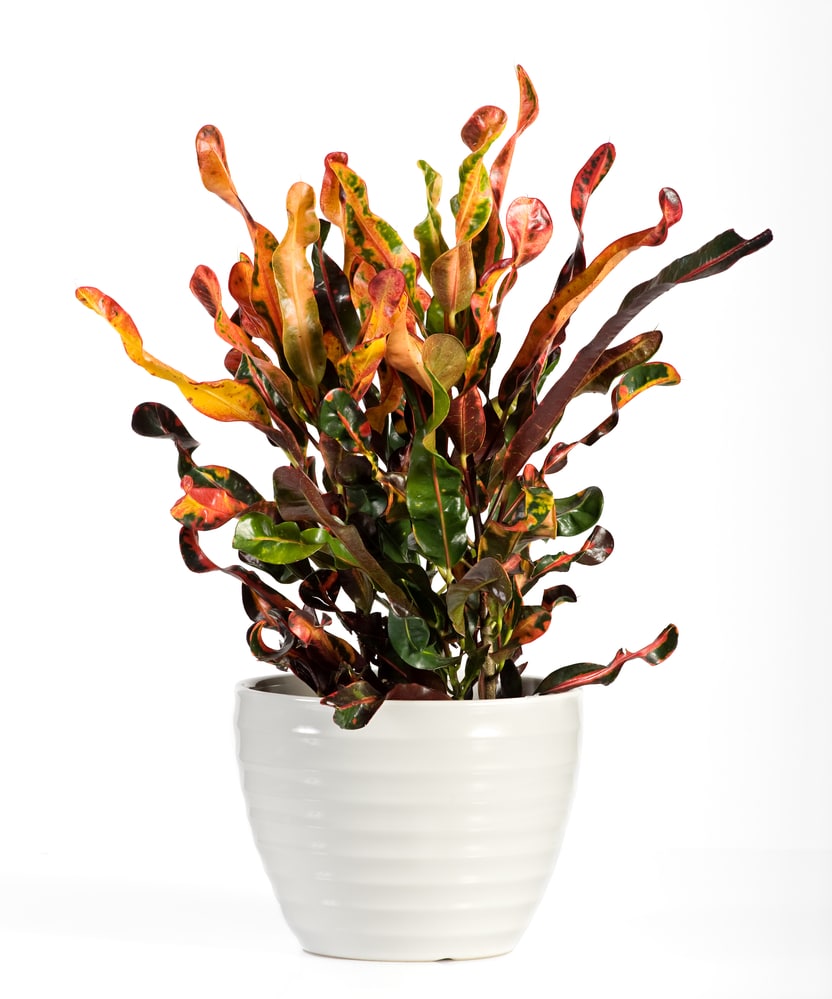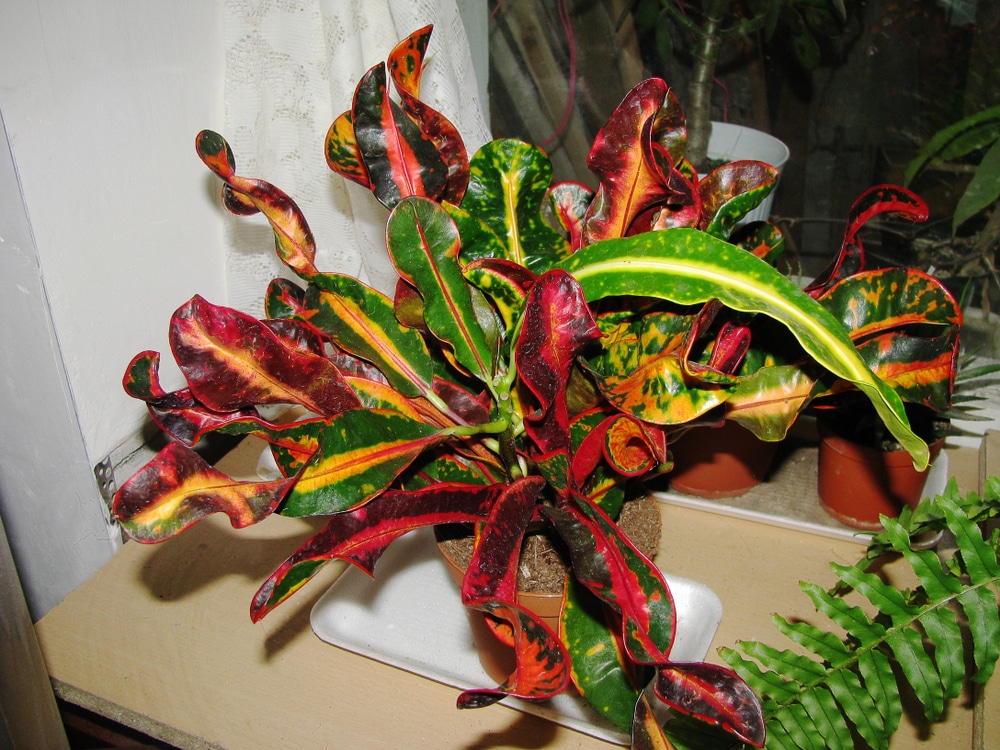The distinctive multi-colored and mottled foliage of the Corkscrew Croton (Codiaeum variegatum var.) is just one reason it is super popular as a houseplant. Crotons are also extremely easy to care for, which is fantastic if you’re looking for an easy and visually stunning new houseplant. The Corkscrew Croton deserves a central location to show off its variegation and unique ruffled leaves.
Origin and History of Croton Mammy
This houseplant is a cultivar of Codiaeum variegatum, the common Garden Croton known for its bright variegated foliage and erect shrub-like growth. There are hundreds of Croton cultivars bred to enhance specific foliage colors, leaf shapes, and growth habits.
The Corkscrew Croton is remarkable for its bright pink, purple, orange, red, and yellow mottled leaves, which grow in an upright twisted or corkscrew manner, creating ruffled leaf edges. Compared to other cultivars, the Corkscrew Croton is a small specimen, making it an ideal houseplant.
All Crotons are native to the tropics of Malaysia, Indonesia, Australia, and the Pacific Islands, where they grow into substantial 9-foot tall shrubs.
Note: The Corkscrew Croton is commonly known as Mammy Croton, Croton Mammy, or Croton Mammi. The word “Mammy” has historic racist associations as a dehumanizing stereotype for black women who worked as domestic slaves or servants. Due to this, we are joining others to spearhead a new common name for this Croton — the Corkscrew Croton.

Codiaeum Variegatum Care
In this section we’ll cover important Croton Mammy care tips such as watering schedules, lighting requirements, fertilizing tips, temperature, humidity, and more.
Growth Habit
The Corkscrew Croton is a slow-grower that averages 2-3 feet tall at maturity and can be just as wide if allowed to spread out. It is a lush, bushy growth with many stems and dense, prolific leaves. In a year, this Croton will grow approximately 10-12 inches.
It features long, finger-like leaves that develop a slightly twisted and curled corkscrew habit as they grow. The leaves are evergreen, thick, shiny, leathery, and heavily veined, adding to their aesthetic appeal as one-of-a-kind beauty. They grow alternately up a singular stem, and one plant will have several to many stems branching outwards.
Corkscrew Croton leaves often start out primarily green with white or light greenish-yellow veining and variegation. As the leaves mature, they morph into a wide array of intensely colorful combinations. The foliage is not uniform – each leaf will develop into its own unique mottled variegated color blend. This is all part of the charm of the Croton houseplant.
Lighting
The amount of sun exposure determines foliage coloration, so it’s essential to be especially mindful about light with this houseplant. After all, we want to see it in its full glory all the time! However, this doesn’t mean it should be put in direct sunlight, as this will burn the leaves. Or, at the very least, bleach the coloring out of the leaves.
The key to keeping the Corkscrew Croton bright and colorful is striking a good balance. It prefers lots of bright, indirect sunlight. A plant that doesn’t receive enough light will develop dull, green leaves without all the brilliant coloring.
A south or west-facing window is best. Set the plant a little away from the window to prevent the direct sun from touching the foliage. Or, use a thin shade or light curtain as a buffer. It’s best not to put the plant directly on the windowsill as this will be too much direct light. And, north-facing windows should be avoided as they don’t get enough sunlight.
Watering
Corkscrew Crotons like consistently moist soil that is not soggy. It does not like drying out entirely and is not drought-tolerant. Always check the soil before watering to ensure you’re not over or under-watering. Stick your finger into the top 2-inches of soil – if it’s dry, add water. Hold off for a few more days if the soil is still moist.
Proper moisture is determined by your watering but also hinges on having good well-draining soil. Poor soil won’t absorb enough water, causing the water to run right through and become soggy at the base. In the wild, Crotons grow in forests where the soil is moist, not waterlogged.
On average, Crotons need watering once a week during the summer and every other week in winter. This will vary by your location and the climate in your home, so only use this as a base guide, and don’t forget always to check the soil beforehand.
Temperature and Humidity
The ideal indoor temperature for the Corkscrew Croton is between 60-80F. And, it likes high humidity between 40-80%.
In the summer, keep this Croton away from air conditioners and, in the winter, away from heat registers, radiators, and cold drafts. It is not tolerant of temperature extremes in either direction.
There are several ways to increase humidity in the home to keep your indoor houseplants happy. A humidifier is a worthwhile investment if you’ve got lots of plants. Another option is a DIY humidifier pebble tray. Fill a pan with pebbles and then with water. Place the plant on top of the stones – as the water evaporates, it adds moisture to the air. Refill the water as needed to keep it working correctly.
A third option for increasing humidity is to mist the foliage. Only do this in the morning, so the water has sufficient time to evaporate before night and cooler temperatures. Leaves that are wet too long may lead to fungus or disease issues.
Soil and Container
Crotons like well-draining soil – a high-quality indoor houseplant potting soil is excellent. Add in handfuls of coco coir and perlite to improve drainage, increase moisture retention, and allow better airflow around the roots. It sounds at cross-purposes to have well-draining soil that also retains moisture, but balance is key.
Choose a container with drainage holes, so water doesn’t accumulate at the bottom of the pot and turn the soil soggy. This will lead to root rot and potentially kill your Croton.
Fertilizer
The Corkscrew Croton doesn’t need much encouragement to grow – it may be a bit slow, but it readily develops without much outside help. Adding a fertilizer three times a year is enough – once in the spring, summer, and fall, and then don’t fertilize in the winter when the plant is resting.
Pruning
Since the Corkscrew Croton grows quite large and dense, it benefits from pruning on a seasonal basis to prevent leggy or unsightly growth. It’s also necessary to prune to keep it small or more compact if you have limited space or want a specific aesthetic. Pinch off top leaves as they emerge to prompt the plant to produce more leaves near the base and create a bushier growth.
Being that it’s a slow grower, you won’t need to prune a lot at once, but it’s helpful to keep up with it, so you’re not all of a sudden faced with a giant unwieldy plant. Remember, it will get as wide as it is tall, so it’s not just the height we’re referring to here.
In addition to yearly aesthetic pruning, remove any dead leaves as needed to keep them looking in top shape. Never cut more than one-third of the plant at once as this may cause shock and prevent new, healthy growth.
***Always wear gloves when pruning a Croton as they produce a milky white sap that may irritate your skin.
Repotting
This Croton benefits from being repotted every two years. It isn’t a fast grower, so usually, it doesn’t need a larger container until then. Repotting also refreshes the nutrients in the soil and alleviates any soil compaction.
Move the plant to a pot just one size bigger so it doesn’t get overwhelmed. Or, if you want to keep the plant the same size, repot it to the same container.
Toxicity
All parts of the Croton are toxic to people and animals. Keep it away from kids and pets. Crotons emit a milky white sap when cut that is irritating to the skin, and you should always wear gloves when pruning it. The liquid causes allergic reactions, irritations, or skin eczema. If you have pets who like to nibble on plants, best avoid this one for their safety.
Be extra careful during handling that you do not get the sap in your eyes or mouth. Crotons aren’t deadly, but poisoning will bring on nausea, vomiting, and diarrhea.
Croton Mammy Propagation
It’s best to propagate the Corkscrew Croton in spring when the plant is at its strongest. If you’ve got a large plant, it’s fine to take several cuttings at once.
Stem Cutting Propagation
- Sterilize a pair of scissors or shears.
- Put on gloves – the plants’ milky sap is an irritant.
- Select a healthy stem at least 3-4 inches long and with at least 3-5 leaves on it.
- Cut it right above the node, the joint where the two stems meet.
- Strip off any leaves on the bottom part of the stem, but leave 3-5 at the top.
- Fill a container with potting soil and water it, so it is moist but not soggy.
- Plant the stem cutting 2 inches into the soil and pat the soil firmly around it, so it stays in place.
- Cover the entire pot with a plastic bag to retain humidity, but leave one corner slightly open for airflow.
- Place in a warm location with bright, indirect sunlight.
- Check the soil moisture daily to ensure it is staying evenly moist.
- The stem cutting will develop roots in 4-6 weeks.
- To check root development, very lightly tug at the stem to see if there is resistance.
- Remove the plastic covering once it has roots and continue caring for it as usual.
Common Pests & Disease
Here are a few common pests and diseases that you should look out for when keeping Croton Mammy:
Crown Gall
Swollen growths on the stems or leaf veins are crown gall, and they must be removed immediately. Use a pair of disinfected shears to cut the growths off, then disinfect the shears again so you don’t accidentally infect other plants.
Soil bacteria cause this disease, and there is no cure for it. You must act quickly to save the plant and prevent the bacteria from spreading.
Spider Mites, Aphids, Mealybugs, and Thrips
These little bugs suck the sap out of plants, leaving brown spots or wilted and yellowing leaves. To catch possible pest infestations early, inspect the plant every time you water. Be sure to look under the leaves, as this is a common place the tiny insects hide.
Treat any infestation as soon as you see it; a small one quickly becomes a big problem if left unchecked. The best solution is spraying the leaves and soil with a neem oil solution.
In a quart-size spray bottle, mix 2 teaspoons neem oil with 1 teaspoon dish soap and fill the rest with water. Shake it well and spray the entire plant from top to bottom. Repeat this every 4-7 days, and continue for a while even after infestation signs are gone as eggs or larvae may be hiding in the soil.
Common Questions and FAQs
Here are a few common questions about Croton Mammy care:
Will my Corkscrew Croton flower?
Most indoor tropical houseplants won’t flower because the conditions aren’t quite right, and the Corkscrew Croton is no different. The flowers are tiny, yellow and white, and subdued, so you aren’t missing too much.
Why is my Croton dropping leaves?
The most likely reason is that the plant is underwatered. Check the soil moisture and water as needed. When soil is allowed to dry out completely, the plant will drop leaves in response.
What causes leaf edges to turn brown?
Brown around the leaf edges is caused by too much watering. Check the soil every time before watering to ensure you’re not overwatering. The top 2 inches of soil should be dry before watering. Another cause may be cold or exceedingly dry air, which are causing the plant to struggle.
Why are the leaves of my Corkscrew Croton dull?
Healthy Croton leaves are shiny, thick, and leathery. If your leaves look less than this, they aren’t getting enough light. Move the plant to a location with more light, but make sure it’s not in direct sunlight.
The plant may also need higher humidity. Try spray misting the leaves in the mornings to increase humidity around the Croton.
Can you propagate a Croton from a leaf cutting?
A leaf-cutting will grow roots, but it will never produce a stem or become a “proper” plant. Put the leaf-cutting in a glass of water, and roots will come out over time. This is a fun way to display abundant leaves around the house, but sadly, they will never develop to mature plants.
The distinctive Corkscrew Croton is virtually fuss-free, given the right amount of light, warmth, and water. And, with good care, your Croton will reward you with splendidly colorful twisting and curling foliage that is unlike any other.

